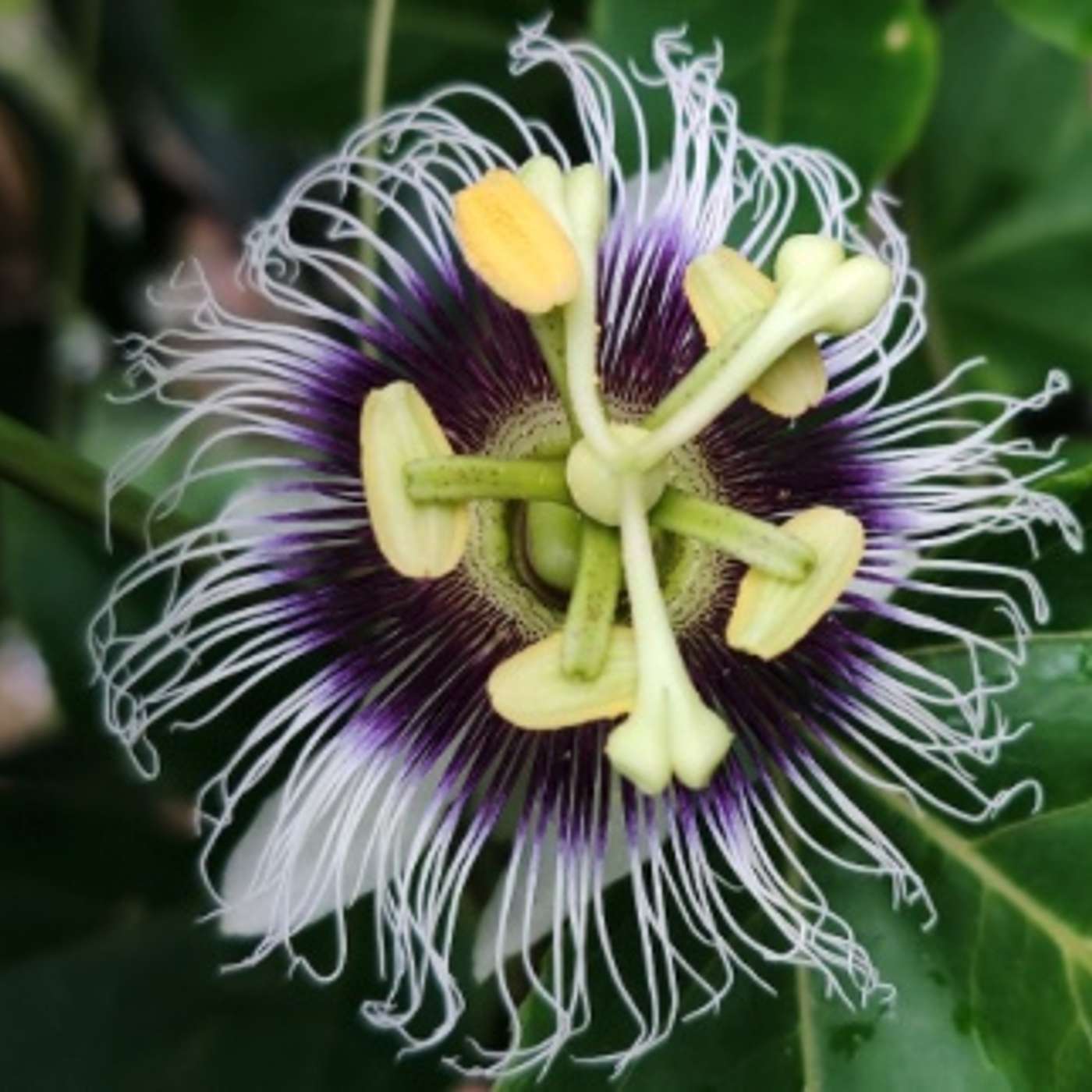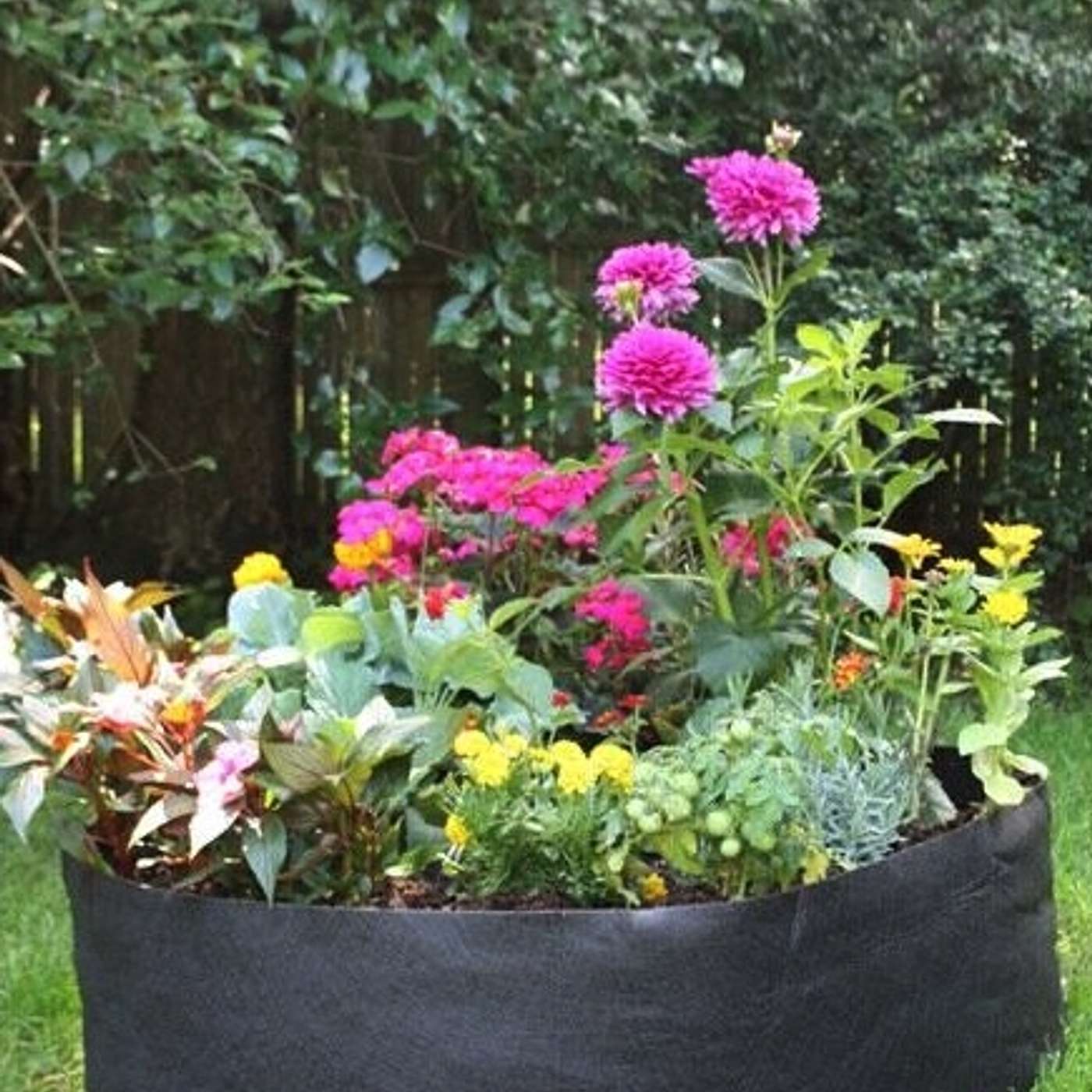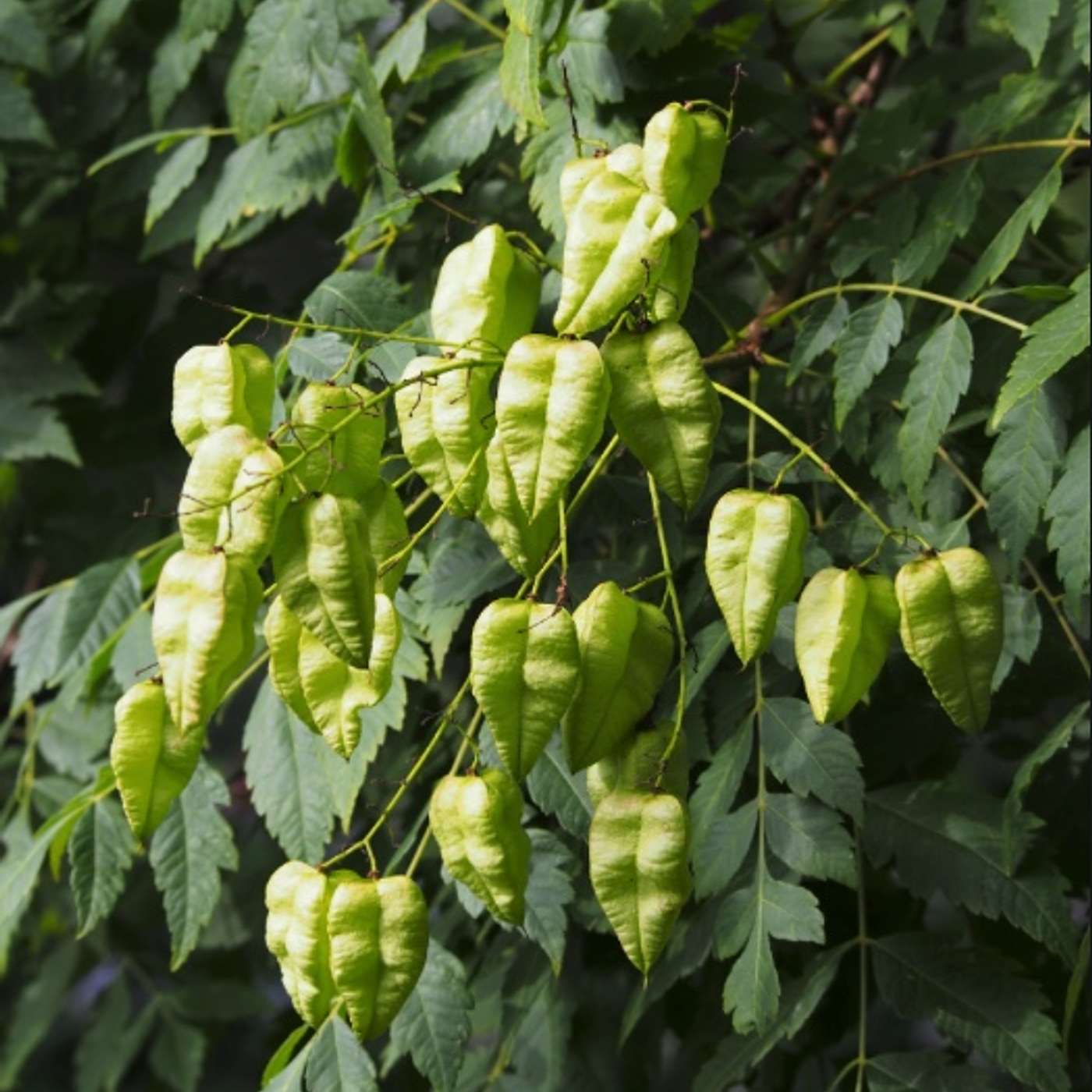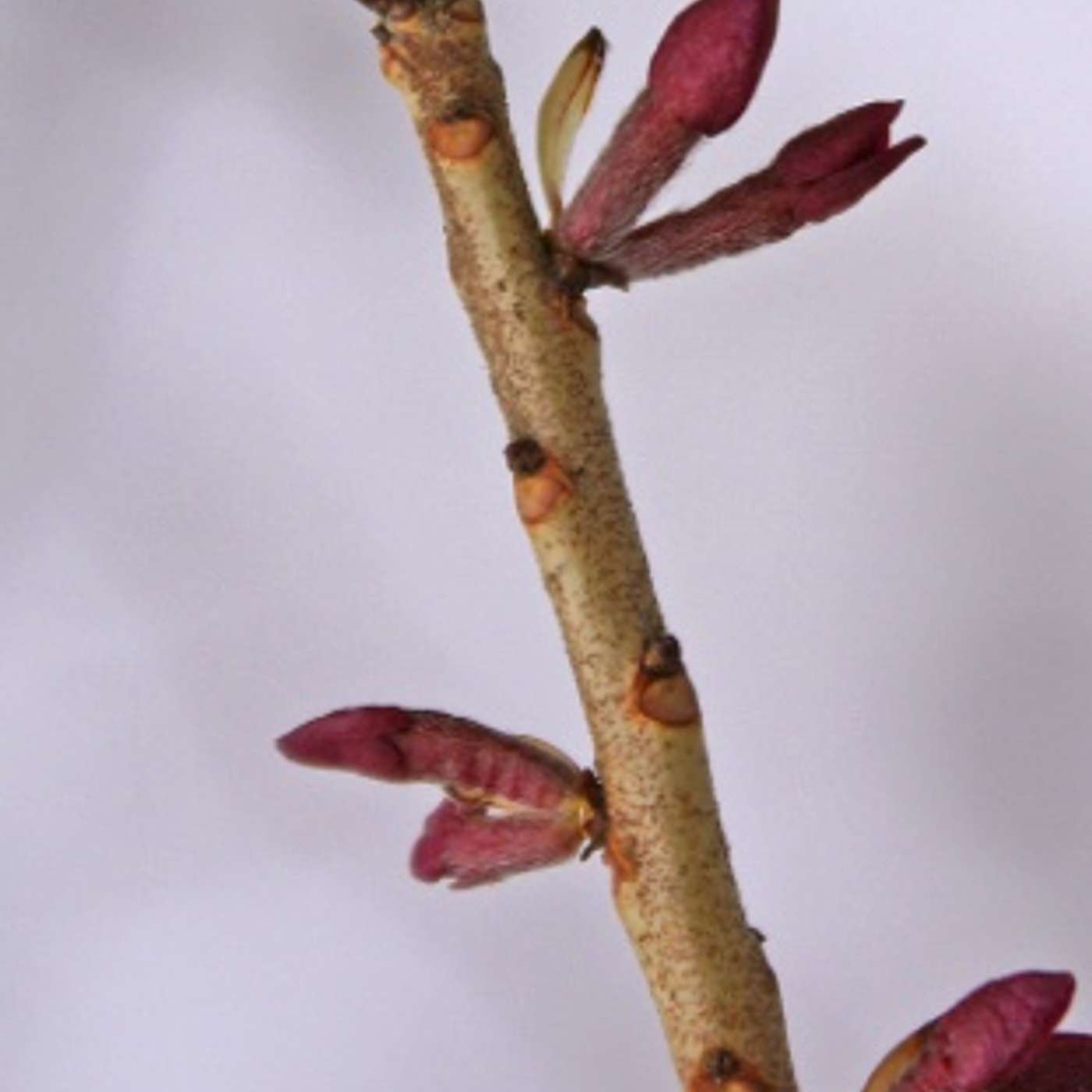Garden Basics with Farmer Fred
119 How to Grow Passion Fruit. The Golden Raintree.
During July, we are giving away Smart Pots when listeners’ submit audio questions. If we use it on the podcast, you will be getting a new, six foot long Smart Pot raised bed fabric planter! Just like Eyal from the San Francisco Bay Area, who is wondering why his passion fruit flowers fell off. We’ll dive into the world of passion fruit today.
The Plant of the Week is a tree with outstanding summertime blooms that can be grown throughout most of the United States, the Goldenrain tree.
Have you ever wondered if that bare stem of a plant is alive or dead? Debbie Flower has tips to help you answer that question.It’s all on episode 119 of the Garden Basics with Farmer Fred podcast, brought to you today by Smart Pots and Dave Wilson Nursery.
And we will do it all in under 30 minutes. Let’s go!
Pictured:
Passion Fruit
Links:
Smart Pots
Dave Wilson Nursery
UC Davis Arboretum
Plants that Attract Pollinators
Alive or Dead? Understanding Epicormic Shoots
More episodes and info available at Garden Basics with Farmer Fred
Garden Basics comes out every Tuesday and Friday. More info including live links, product information, transcripts, and chapters available at the home site for Garden Basics with Farmer Fred. Please subscribe, and, if you are listening on Apple, please leave a comment or rating. That helps us decide which garden topics you would like to see addressed.
Got a garden question? There are several ways to get in touch:
Leave an audio question without making a phone call via Speakpipe, at https://www.speakpipe.com/gardenbasics
Call or text us the question: 916-292-8964.
E-mail: fred@farmerfred.com
or, leave a question at the Facebook, Twitter or Instagram locations below.
Be sure to tell us where you are when you leave a question, because all gardening is local.
And thank you for listening.
All About Farmer Fred:
Farmer Fred website: http://farmerfred.com
Daily Garden tips and snark on Twitter @farmerfred
The Farmer Fred Rant! Blog
Facebook: "Get Growing with Farmer Fred"
Instagram: farmerfredhoffman
Farmer Fred Garden Videos on YouTube
As an Amazon Associate, I earn from qualifying purchases from possible links mentioned here.
Thank you for listening, subscribing and commenting on the Garden Basics with Farmer Fred podcast and the Beyond the Garden Basics Newsletter.
During July, we are giving away Smart Pots when listeners’ submit audio questions. If we use it on the podcast, you will be getting a new, six foot long Smart Pot raised bed fabric planter! Just like Eyal from the San Francisco Bay Area, who is wondering why his passion fruit flowers fell off. We’ll dive into the world of passion fruit today.
The Plant of the Week is a tree with outstanding summertime blooms that can be grown throughout most of the United States, the Goldenrain tree.
Have you ever wondered if that bare stem of a plant is alive or dead? Debbie Flower has tips to help you answer that question.It’s all on episode 119 of the Garden Basics with Farmer Fred podcast, brought to you today by Smart Pots and Dave Wilson Nursery.
And we will do it all in under 30 minutes. Let’s go!
Pictured:
Passion Fruit
Links:
Smart Pots
Dave Wilson Nursery
UC Davis Arboretum
Plants that Attract Pollinators
Alive or Dead? Understanding Epicormic Shoots
More episodes and info available at Garden Basics with Farmer Fred
Garden Basics comes out every Tuesday and Friday. More info including live links, product information, transcripts, and chapters available at the home site for Garden Basics with Farmer Fred. Please subscribe, and, if you are listening on Apple, please leave a comment or rating. That helps us decide which garden topics you would like to see addressed.
Got a garden question? There are several ways to get in touch:
Leave an audio question without making a phone call via Speakpipe, at https://www.speakpipe.com/gardenbasics
Call or text us the question: 916-292-8964.
E-mail: fred@farmerfred.com
or, leave a question at the Facebook, Twitter or Instagram locations below.
Be sure to tell us where you are when you leave a question, because all gardening is local.
And thank you for listening.
All About Farmer Fred:
Farmer Fred website: http://farmerfred.com
Daily Garden tips and snark on Twitter @farmerfred
The Farmer Fred Rant! Blog
Facebook: "Get Growing with Farmer Fred"
Instagram: farmerfredhoffman
Farmer Fred Garden Videos on YouTube
As an Amazon Associate, I earn from qualifying purchases from possible links mentioned here.
Thank you for listening, subscribing and commenting on the Garden Basics with Farmer Fred podcast and the Beyond the Garden Basics Newsletter.
GB 119 Passion Fruit. The Goldenrain Tree.
22:58
SPEAKERS
Quentyn Young, Warren Roberts, Eyal of SF, Debbie Flower, Farmer Fred
Farmer Fred 00:00
Garden Basics with Farmer Fred is brought to you by Smart Pots, the original lightweight, long lasting fabric plant container. it's made in the USA. Visit SmartPots.com slash Fred for more information and a special discount, that's SmartPots.com/Fred.
Farmer Fred 00:20
Welcome to the Garden Basics with Farmer Fred podcast. If you're just a beginning gardener or you want good gardening information, you've come to the right spot.
Farmer Fred 00:32
During July, we're giving away Smart Pots to listeners who pose audio questions. If we use it on the podcast, you're going to be getting a new, six foot long, Smart Pot raised bed fabric planter, just like Eyal from the San Francisco Bay Area, who is wondering why his passion fruit flowers fell off. We're going to take a deep dive into the world of passion fruit today. And the Plant of the Week is a tree with outstanding summertime blooms that can be grown throughout most of the United States. It's the golden rain tree. It's all on episode 119 of the Garden Basics with Farmer Fred podcast, brought to you today by Smart Pots and Dave Wilson nursery. And we'll do it all in under 30 minutes. Let's go.
Farmer Fred 01:20
As you know, when you call us with a garden question during the month of July here on the Garden Basics podcast, you could win yourself a free Smart Pot, a six foot long raised bed fabric planter from Smart Pots. It's rectangular in shape, built in partitions, 16 inches wide, 16 inches tall, and six feet long. It holds over 10 and a half cubic feet of soil. All you have to do is leave us an audio question. And if we use it on the air, you're going to win a Smart Pot this month. A couple of ways you can do that. You can call 916-292-8964, 916-292-8964. Leave us a voice message. Or you can go to speakpipe.com slash gardenbasics. And just yell your question at your smartphone or your computer. That's speakpipe.com slash gardenbasics. So we're going to be giving away Smart Pots all July if you call in with a question and we use it on the air. And you could win yourself a Smart Pot, just like Eyal from the San Francisco Bay Area who has a question about a tropical fruit.
Eyal of SF 02:29
I planted a passion fruit in my yard in late May. And at first, the passionfruit is great, and it had flowers and the flowers even set fruit. But now, a few months later, it sends out a few more flowers but they all fell off and not turning into fruit. And I've been fertilizing the passion fruit with an organic 5-4-5 fertilizer and I've been watering it once or twice a week and it's been going great. I just wonder if I've done something wrong or expecting too much from this young passion fruit to set even more fruit than the original batch. I live in USDA zone 9B and Sunset Zone 16. Thank you. Love your show. Bye.
Farmer Fred 03:18
The San Francisco Bay Area is divided into many different climate zones. If you ever have visited San Francisco or any of the coastal areas in Northern California during the summertime, you know how darn cold it can be. Well, where this person is, in Sunset zone 16, it's a little bit more inland, not by much, but just a bit. It's a thermal belt area that the Sunset garden book describes as one of Northern California's premier horticultural areas. So he's in the right area to be growing that passion fruit. What could cause passion fruit to not flower after it has produced? Well, let's ask somebody who knows something about passion fruit. Quentyn Young, manager of a local nursery here in the Sacramento area, Fair Oaks Boulevard Nursery. Quentyn, a little bit of knowledge for us, please, about passion fruit. This really does take a very mild climate to grow in, doesn't it?
Quentyn Young 04:15
Yeah. And they do. They do well here in the general kind of Bay Area, Sacramento Valley area.
Farmer Fred 04:22
So, they don't like weather, I would think, that's either too cold or too hot.
Quentyn Young 04:26
Exactly. Yeah. So sometimes in the Central Valley, it can be a little bit hot. We start getting these 105 days and then further north of here, especially in the foothills, you're probably gonna be struggling trying to keep it looking good during the winter.
Farmer Fred 04:39
Yeah, Bay Area people, though, they have a fairly mild climate and very seldom gets above 90. Seldom drops below 40 in some parts of the Bay Area. But it's been kind of a weird summer so far.
Quentyn Young 04:53
Very strange. Yes.
Farmer Fred 04:55
So what are some of the causes, you think, of those flowers falling from the passion fruit?
Quentyn Young 05:00
Well, I the first thing I would ask is how I'm watering. How is it getting irrigated and how often and how much? So if the plant is, let's say, drought stressed, it could drop its flowers like most flowering plants would. That would be one thing I would check. The second one, I would look to see if you have any pollinators with the passion fruit, you want to make sure that the flowers really do well at attracting bees, specifically carpenter bees. If you don't have any bees around, you might want to get a little paintbrush and pollinate the flowers yourself. Third thing I would look at is fertilizing, you don't want to over fertilize, because you're going to end up with a lot of leaves at the expense of flowers. So those would be the three main things I would look for.
Farmer Fred 05:49
Now I think one thing we don't know about this situation: is this plant in a container or is it in a ground? If it's in a container, and with the heat waves that we've been having? That could be the issue?
Quentyn Young 06:04
Yeah, even our canned vines right now like on a day like today, we are watering twice, once in the morning and once in the afternoon.
Farmer Fred 06:15
So give us some working knowledge about passion fruit, how is it best consumed?
Quentyn Young 06:21
You can eat it fresh, you know, slice it open, usually you want to strain the pulp off the seeds. Um, you can definitely buy passion fruit pulp, you can buy passion fruit juice, but usually you scoop it out and you separate the pulp from the seeds.
Farmer Fred 06:37
And what does it taste like?
Quentyn Young 06:38
Boy, it tastes like passion fruit. It just has like one of those great tropical flavors like pineapple or guava. You know, it's just it's hard to describe unless you've had it, but boy, it's really good.
Farmer Fred 06:51
And what is the best way to grow it? Does it require a trellis?
Quentyn Young 06:54
Yes, it's gonna want a trellis. You want to give it at least six feet by six feet. You could even give it 10 by 10. It does like to climb. It does love the heat. The warmer it gets the better, though you do want to keep an eye on it when we start getting these days that are over 100 degrees and don't overfertilize them. Like I said earlier, you'll get lots of leafy growth at the expense of flower,
Farmer Fred 07:19
Full sun or part shade?
Quentyn Young 07:21
I would do full sun. If you're going to do part shade, then try to get in the morning shade and the afternoon sun which is the best.
Farmer Fred 07:31
For those of you that live in mild climates, zone nine, zone 10, it might be worth a shot. try a passion fruit for yourself.
Quentyn Young 07:39
Yes, they're a great under a grapevine, beautiful flower that then will produce the fruit. But like I said you're gonna want to keep an eye out for either hummingbirds, carpenter bees, bees, because the flowers will need to be cross pollinated.
Farmer Fred 07:53
All right. Or put in some plants that will attract some beneficial pollinators, and we will have a link to some of those plants to attract the pollinators in today's show notes. Quentyn Young, Fair Oaks Boulevard Nursery, thanks for feeding us some passion fruit advice. Thanks for having me on.
Farmer Fred 08:15
You've heard me talk about Smart Pots, the award winning fabric planter here on the Garden Basics podcast. They're durable and reusable. I've been using mine for five years now. And once again, they're being pressed into service in my yard. Yeah, I have this problem. I grow too many tomatoes for the amount of allotted sunny space I have for them. So those extra tomato plants go into the Smart Pots. I place them in scattered areas around the yard where I know they'll get enough sun, which is a premium in my yard. And even five years later, I can pick up those Smart Pots, plant and all, and move them around without fear of the Smart Pot tearing or ripping. Smart Pots are made of breathable fabric, which creates a healthy root structure for plants. And, Smart Pots come in a wide variety of sizes and colors. Visit smartpots.com/Fred for more information about the complete line of Smart Pots, the lightweight fabric containers. And don't forget that "slash Fred" part. Because on that page are details of discounts when you buy Smart Pots on Amazon. Okay, now I understand maybe you want to see the Smart Pots before you buy them. That's not a problem. Smart Pots are available at independent garden centers and select Ace and True Value stores nationwide. To find a store near you, visit smartpots.com slash Fred.
Farmer Fred 09:39
Every week here on the Garden Basics podcast we like to talk with Warren Roberts. He is the superintendent emeritus of the UC Davis Arboretum and Public Garden. And he always has a Plant of the Week for us. And today, it's a tree that puts on a summertime show. It's a tree you can grow in just about any place in the United States of America or other parts of the world for that matter. And Warren, I know it as the golden rain tree, what do you know it as?
Warren Roberts 10:06
I know it is the golden rain tree and I also know it as Koereuteria paniculatum.
Farmer Fred 10:12
I'm glad you said that and not me.
Warren Roberts 10:15
Oh, it's a rather small tree typically, although it can get up to 30-40 feet in time. I think. It usually has a slightly picturesque trunk. This time of year it's completely covered with big clusters of bright yellow flowers, and the petals fall out of the tree, kind of like rain. The common name, golden rain tree, actually is a pretty good one. I'm trying to think if it has any drawbacks. The only drawbacks I can think of is that the seeds do tend to germinate, it tends to naturalize, and it can become a little bit weedy. But I think pretty easy to control.
Farmer Fred 10:55
I don't think you would use it as a shade tree because it casts very light shade.
Warren Roberts 11:00
Well, it does cast slight shade, but I think it cast better shade than let's say a palo verde tree or a Chilopsis. But yeah, the shade is pretty good. It's been grown in California for a long time. Originally from China, I think. And the seeds look like almost like BB's. And they're hard like that, too. So it's not a terribly good idea to plant one over a smooth sidewalk because it can tend to propel you in directions you don't particularly want. In fact, one of the ways to remember this specific epithet is: "You plant it today and it will paniculata". It's such a beautiful display of flowers. Then the pods are beautiful green, triangular, like little triangular balloons and big clusters. Eventually those turn brown and they hang on the tree a long time. And that annoys some people, but they make a nice rattling sound in the wind.
Farmer Fred 12:07
Yeah, these look like Japanese lanterns.
Warren Roberts 12:10
They do indeed. I remember when I was a little kid seeing a book about flower arrangements. This is back in the mid 40s. And there was a picture using one of these as part of a flower arrangement. I was so intrigued. I've never forgotten that. I think I was four. But we have them in the United States for a long time. I think it's a tree that could be planted a lot more, especially it gives this wonderful show for yellow flowers and this time of year. There are some other species but they tend to be more tender. There's one called Koereuteria bipinnata. The Chinese flame tree is the common name of it. It has kind of salmon colored pods. It's not my favorite of the three. I liked it the least, although it can become a magnificent tree. Every seed seems to germinate. The other one called Koelrueteria elegans, the Formosan flame tree or sometimes called Flamegold. It has actually become a weed in the southeastern US. But it's one of my favorite trees. It's so beautiful. It's from the mountains of Taiwan. it blooms late in the summer with yellow flowers and then has red pods like big clusters of triangular balloons that lasts until frost. Although I think that of the three, the one that has the widest practical use would be Koelreuteria paniculata, the golden rain tree. I mentioned the common name. There are some tropical trees in the Genus Senna or Cassia which are sometimes called golden rain tree, too, but it's a different family and definitely tropical.
Farmer Fred 13:48
The Golden rain tree gets about 20 to 35 feet tall with about a 25 to 40 foot spread, a good size for a small yard. And of course, the show of the yellow flowers. It's an under appreciated tree, there's no doubt about it.The golden rain tree, Koelreuteria paniculata.
Warren Roberts 14:07
And it's deciduous, that is a winter deciduous, so it lets in the winter sun.
Farmer Fred 14:11
There you go. Golden rain tree. Check it out. Warren Roberts is the superintendent emeritus of the UC Davis Arboretum and Public Garden. Check out the Arboretum online, at arboretum.uc davis.edu . Warren, thanks for another great Plant of the Week.
Warren Roberts 14:26
You're welcome, Fred.
Farmer Fred 14:37
You have a small yard and you think you don't have the room for fruit trees. Well, maybe you better think again. Because Dave Wilson Nursery wants to show you how to grow great tasting fruits, peaches, apples, pluots and a lot more in small areas. You could even grow them in containers on patios, as well. It's called backyard orchard culture. And you can get step by step information via the Fruit Tube videos at DaveWilson.com. And that's where you're going to find the closest nursery to you that carries Dave Wilson's quality fruit trees. So start the backyard orchard of your dreams at DaveWilson.com.
Farmer Fred 15:17
We like to answer your garden questions here on the Garden Basics podcast. We bring in Debbie Flower, our favorite retired college horticulture professor to show us the light. To lead us through the morass that we call the world of plants. It can be confusing.
Debbie Flower 15:31
Wow, big responsibility, you're laying me there, Fred.
Farmer Fred 15:34
That's okay. I know you can handle it. From North Eastern Ohio. We get an email from Kirk, who writes in who says, "Hello, Fred and Debbie. Greetings from a longtime podcast listener in Ohio USDA hardiness zone 6A."Thank you for that Kirk. He says, "I'm seeking your guidance regarding some plants that I germinated in the spring and wintered over in six inch pots buried in my garden. Just as they were breaking dormancy a few months ago, some unidentified vermin bit the main six inch tall stalks down to ground level. I had hoped that new foliage would have flushed out by now, as what's left of the stems remains supple and green when I scratched them with my nail. They're getting plenty of sun and moisture, but no signs of new growth. I'm thinking of jumpstarting the leafing by feeding the roots with some nitrogen fertilizer. Please let me know what you think. I fear these plants will languish until they finally give up the ghost. The saplings are a Western soapberry tres and desert Willow plant". I will remind you Kirk is in northeastern Ohio. "I've become very adept," Kirk says, "over the years of collecting seeds during my travels around the country and stratifying and scarifying them when necessary prior to germination". Stratifying usually means giving them some...
Debbie Flower 16:56
fake winter.
Farmer Fred 16:57
fake winter. Yes, sticking them in the refrigerator.
Debbie Flower 16:59
He might just leave them outdoors. But yeah.
Farmer Fred 17:01
And scarifying could be anything from sandpaper to soaking them in water, right?
Debbie Flower 17:06
It's scarring the seed coat, to allow water into it. So it starts with those letters, S-C-A-R.
Farmer Fred 17:13
So he is not an amateur at this.
Debbie Flower 17:15
No, he must do his research. Sounds like a very interesting piece of property. And I can totally relate to collecting seeds in parking lots, in strange places and bringing them home and trying to grow them because that's the fun of it. Yes, kudos to you Kirk. Right.
Farmer Fred 17:29
He says my property is quickly becoming a diverse Arboretum of trees and plants from all of the lower 48 states and some Canadian provinces. I'll continue listening to your show for your suggestions. Well, where do you want to start with this? First of all, I would say give it time for one thing because a lot of plants after a hard freeze, we might be tempted to take it out or pull or trim off dead foliage or dead branches thinking they're dead when in reality, as Kirk found out by a scraping test of bark, that it would be still green. I'll leave it there. A lot of people make the mistake of pulling them too early when sometimes it could be May or June before they break bud.
Debbie Flower 18:13
Right. I assume they're still in six inch pots. It was a clever technique to bury them. During the winter. They and both of those plants are hardy to zone six. So they are able to take the chill that zone six would provide an exposed six inch pot in zone six would get much colder than a buried one. And planted, an exposed six inch pot outdoors in USDA zone 6A in the winter would probably not have survived. So kudos to Kirk, for burying them, a young plant that loses its top can be vulnerable to death. If a plant is going to regrow, if a plant loses its top to the vermin and is going to regrow, it needs to have either a bud below the part that was taken away. So as a bud on the stem that's still there, or enough food stored in the roots of that plant that it can produce what are called epicormic shoots. Yeah, epicormic shoots are shoot set arise from places that were not previously planned. Plants are actually very well organized and they actually have a number, a fraction. If you look, start at the top of the stem and go around the stem and down the stem. It's the number of times you go around a stem till you come to a leaf that's just below the leaf where you started. Is that make sense? No. I didn't follow that. Plants are very organized. When they grow naturally, they produce buds at predetermined places. So they'll have an alternate arrangement meaning one leaf at a plate on the stem at the location and one leaf further up. Or they'll have opposites. So they'll have two leaves at the same location sometimes there whorled which means three or more at the same location. So that kind of organization exists in the DNA of the plant. If for some reason it loses the pre determined buds, then buds have to arise randomly and that's what an epicormic bud or an epicormic shoot is, it arises randomly. The plant has to mobilize chemicals and nutrients and such to create the bud and then cause it to open and grow. And I fear that because the plants Kirk has are so young that they don't have enough food stored in the roots to allow the plant to produce epicormic shoots and so the what's left as a possibility is that there's a bud and you don't always see them they can be under the outside of the stem in a place where we can't see them. But there could be a bud there. And he asks about potentially fertilizing them with nitrogen and I would say give it a try. Just don't make the nitrogen too strong.
Farmer Fred 21:02
Yeah, he talked about feeding the roots with nitrogen, right. If you want more root growth, wouldn't you feed them phosphorus and potassium?
Debbie Flower 21:12
Well yeah, but if there's a bud above ground that's not able at this moment to grow, the nitrogen might be helpful. So a balanced fertilizer Yeah, but at quarter strength maximum.
Farmer Fred 21:26
My fear is when he talks about adding nitrogen he's gonna go throw some sulfate of ammonia on it, right.
Debbie Flower 21:31
Which would just burn it. Yeah,
Farmer Fred 21:32
So yeah, something low dosage, definitely something with nitrogen in a single digit.
Debbie Flower 21:38
Yes. Like Like a fish emulsion, right? Yeah, right.
Farmer Fred 21:44
Something like that. That which is a 5-1-1 or a 5-2-2 referring to the content of nitrogen, phosphorus and potassium. But again, you know, give it time, too. Yes. As the weather warms. That's the other thing, too, is soil temperature.
Debbie Flower 21:59
I have a Desert Willow and I have to say I look at it every year and wonder, Did something go wrong? Did it die? Because it's very slow to come out in spring.
Farmer Fred 22:07
Okay, well there. Kirk, there you go. That's your answer. Be patient. Be patient.
Debbie Flower 22:12
Yes. Fertilizer can't hurt, especially for a plant in a container. And if the fertilizer is weak.
Farmer Fred 22:18
Congratulations on all your travels, Kirk, and assimilating an arboretum in northeastern Ohio.
Debbie Flower 22:24
Very cool. Yeah.
Farmer Fred 22:25
Very good. Kirk. Debbie Flower. Thanks for helping us out here.
Debbie Flower 22:29
You're welcome, Fred.
Farmer Fred 22:35
Garden Basics comes out every Tuesday and Friday. It's brought to you by Smart Pots. Garden Basics is available wherever podcasts are handed out. And that includes Apple, Iheart, Stitcher, Spotify, Overcast, Google, Podcast Addict, Cast Box, and Pocket Casts. Thank you for listening, subscribing and leaving comments. We appreciate it.




